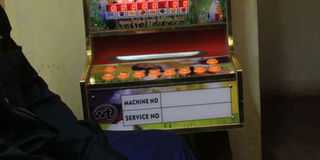How technology adoption is shoring up lottery sector

Nyeri residents use a lottery machine on October 3, 2016. The lottery machine exists in two forms: The gravity pick and the air mix machine. PHOTO | JOSEPH KANYI | NATION MEDIA GROUP
What you need to know:
- Technology has played a major part in the unprecedented growth of the lottery sector in Kenya.
- USSD has become a game changer for the sector and will continue to be.
Technology has been the buzz word in Kenya for the past few years.
Every sector is mulling technology adoption and how it can spur innovation.
Budgets for research and development teams continue to rise in a bid to apply technology effectively.
GAMING
Consequently, such efforts have birthed innovations like Uber, Airbnb and most recently M-Akiba by the Central Bank of Kenya – all signalling that technology is the way to go.
However, when it comes to the gaming and lottery sector, technology is more often than not considered a distant thought.
Rarely are the two even linked. To many, this sector has little or no technology influence or adoption.
This is unfortunately far from the truth.
LOTTERY MACHINE
Technology has played a major part in the unprecedented growth of the lottery sector in Kenya.
In fact, it has been key and has evolved greatly.
To begin with, the single most visible part of the lottery – the lottery machine – is a product of physics, mathematics and an innovative use of a confined space to create the random and entertaining phenomenon.
It exists in two forms: The gravity pick and the air mix machine.
STATISTICAL ANALYSIS
Invented in the late 1990s, these two types of machines were designed and proven using statistical analysis to produce random combinations of numbers.
How this is enabled is a product of innovation.
The air mix machine is the most common globally and it uses numbered plastic balls that are carefully calibrated for size and weight.
The balls are placed in the machine that has jets of air blowing through a chamber to mix them up after which a time controlled mechanism selects winning numbers.
ONLINE CONSUMERS
This earlier technology has given way to mobile and web-based software applications that have enabled consumers – using sophisticated algorithms and programmes developed by some of the best app developers in the world – to participate online.
Customers can now purchase lottery tickets with ease through USSD (a global system for mobile communication technology) codes provided by all telcos from the most basic devices.
The Communications Authority estimates Kenya now has 39.7 million mobile subscriptions and mobile is fast becoming the channel of choice for busy punters looking to participate while on the move.
SECURITY
Coupled with the mobile money functionality provided by telecom providers in Kenya like M-Pesa, USSD has become a game changer for the sector and will continue to be.
In addition, these highly specialised applications can now facilitate online draws that are not only random but secure.
Online draws, however, pose a credibility challenge because indeed we are all a seeing-is-believing generation.
In addition, questions about security arise in any technology driven sector or business and, as such, security remains a challenge that the sector must work hard to surmount.
INNOVATION
Data analytics and big data technology has also been effectively used in the lottery sector to provide interesting consumer behaviour and trends.
This data, when mined, will be used to innovate and effectively sell lottery products.
Microsoft – one of the world’s top technology giants – already has a pending patent in America for the development of an innovative system that experts believe will be used by the tech company to venture into the world of gaming and lotteries.
In addition, robots that will be fuelled by dynamic algorithms, motion-tracking cameras and microchips capable of decoding tons of real-time data will increasingly dominate high-stakes betting and lottery activity.
VOTER PATTERN
American presidential hopeful in the 2016 elections Hillary Clinton used big data in her campaign to make strategic decisions on which states to visit more during her tours, where to air television adverts and even when to post campaign messages on Twitter.
The American Green Card is also a lottery that has been in existence for 20 years now and which has lately adopted data analytics in a bid to effectively select eligible applicants in the wake of an increased push by American Senate to increase controls as radicalisation and terrorism soars globally.
Does the lottery have a place for even more technology adoption and innovation?
The answer is an emphatic “Yes”.
However, this growth creates legislative and regulatory minefields that must be navigated if the sector is to continue growing.
The writer is the Head of Marketing, Pambazuka National Lottery




